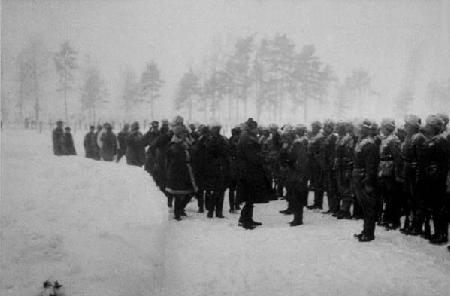


To carry out this plan, the Finns who had escaped to the Soviet Union in 1918, formed the People’s Government of Finland, led by O.W. Kuusinen. This puppet government never came to much power in Finland, as the red army was incapable of destroying the Finnish army. Rapid advances, in the style of "Blitzkrieg", were unsuccessful, greatly owing to the familiarity of the Finns of their own terrain, which they could take full advantage of, and which prevented the enemy from taking advantage of their superior numbers in the winter conditions. On the Karelian Isthmus, the Russian advance was held up by the chain of forts, the so-called Mannerheim-line, named after Marshal Mannerheim, Commander-in-Chief of the Finnish army. On the eastern border of Finland Russian troops, who were obliged to use the roads, were blockaded in several places. They suffered great losses and the attack halted.
In February, the red army, now double in size, began an attack against the Mannerheim-line, which finally led to a breakthrough. The Finns withdrew slowly on the Isthmus to new defence lines, first to the intermediate position, then to the rear position. In early March, battles were fought on the western bank of the Gulf of Viipuri and in the neighbourhood of the city itself. The red army had suffered substantial losses – altogether 100,000 casualties during the Winter War – and had difficulties in organizing their maintenance and supply, but, on the other hand, the resistance of the Finns too, began to give way, as reinforcements were hard to come by.
England and France had offered Finland military aid with the intention of taking the ore resources of Sweden under their control. As the World War threatened to spread into Scandinavia, Stalin considered it better to negotiate the terms with Finland. In the Moscow Peace Treaty, signed on 12 March, 1940, the Soviet Union abundantly gained the areas she had claimed before the war, but gave up the Kuusinen government.
World War II | Pacific War | Winter War | Headquarters | Mannerheim Line | Vilho Petter Nenonen | K.L. Oesch | Harald Öhquist | Paavo Talvela | Continuation War |Transit Pact | Risto Ryti | Order of the Day of the Sword Scabbard | Erik Heinrichs | A.F. Airo | Hugo Österman | Marshal's Drink | Mannerheim Cross | Title of Marshal of Finland | Air War - Air Forces
COURSE OF LIFE | FAMILY | TIME OF GROWTH | MILITARY CAREER | WAR OF INDEPENDENCE | REGENT 1918-1919 | CIVILIAN | DEFENCE COUNCIL | COMMANDER-IN-CHIEF 1939-1946 | PRESIDENT OF THE REPUBLIC 1944-1946 | RETIREMENT | SPECIAL TOPICS | SEARCH